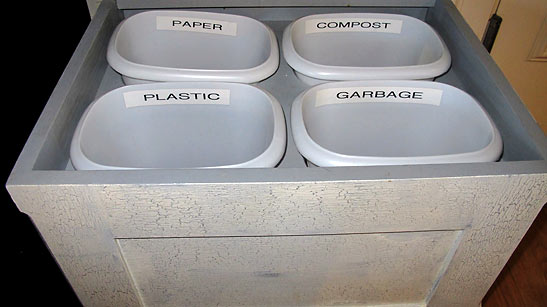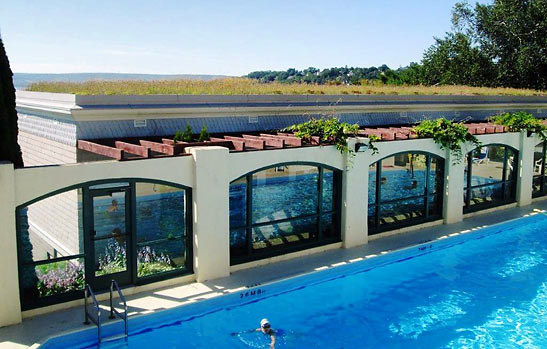 |
 |
|
 |

|
Digby Pines:
Where Eco-Friendly Rises To The Level of High Tides Story by Fyllis Hockman Photographs by Victor Block
We rarely encounter the European standard of motion-controlled hallway lighting. Or placing the room key into a slot that turns on the lights and AC when we enter, and turns them off when we leave. Too many Americans, it seems, prefer to have their rooms already chilled and lit when they return. So the Green Suite at Digby Pines in Nova Scotia, Canada is an anomaly. Okay, so not really a U.S. phenomenon but close enough at least so that we can lay claim a little just by leaning over the border. And how often is a room on the itinerary of a property inspection simply because of its environmental attributes? I was virtually jumping up and down on the bamboo-infused bed linens with excitement at my newly discovered eco-friendly accommodations!
Bamboo, it seems, is a natural fabric that is very hyper-allergenic so the fibers are used in the towels and sheets; bamboo shutters adorn the windows. The headboard is made from a re-cycled door. The cooling and heating system is more energy efficient than normal AC/heating methods. And a recycling trash bin is divided into four units – one each for paper, plastic, compost and garbage.
Now admittedly, I didn't know whether the saran-type wrap protecting the plastic cups in the bathroom should be put into garbage, paper or… maybe even plastic. But I loved having the choice and only regretted not ordering in pizza so I could at least have SOMETHING to compost. Much of the furniture was refinished or made with no carbon footprints and natural decorations of stone and driftwood and local artwork added pizazz to the room. The dual-flush toilet was just a bonus. I cringed when I saw the 1200 watt hair dryer knowing how long it takes my 1875 watt version at home to dry my hair. I'm still at a loss to understand how the tiny implement managed to dry my hair in record time. There were a lot of other less-obvious and more scientific nods to environmental awareness and sustainability that cumulatively I knew made a huge difference. I was eco-humbled.
And fortunately, the eco-friendly efforts extended beyond the Green Suite. Low-level electricity is used throughout the hotel with an emphasis on natural light; the kitchen recycles to such a degree that nothing, I was told, even goes to a landfill; the chef grows his own herbs, and there's a green roof atop the spa that in addition to providing a home to a vast number of plants also impacts building sound and heat insulation, improves air quality, retains storm water as well as provides other environmental benefits. I wanted to jump up and down on the roof, as well!
The spa, warm and quiet under its green roof, uses Aveda all-natural products which supposedly are the greenest on the market (Aveda apparently uses wind power to manufacture their products). The spa also has cork flooring, which not only helps with noise reduction, but is kind to the feet of masseuses and hairstylists standing for long periods of time. Happy feet those! In cabins with fireplaces, compressed sawdust replaces wood because it has a zero percent carbon footprint. Natural gas has, of course, replaced oil, and there is even a "Green Team" comprised of staff members assigned to come up with new ways to save energy. The composting bin in the Green Suite was one of their ideas. Digby Pines may not yet have equalled European standards but they're trying. Of course, even the most eco-friendly of rooms is not enough reason to stay in one, so I ventured out to explore the immediate environs of Digby and Annapolis Royal. Digby is known for two things not usually found on your standard travel itinerary. The Bay of Fundy has the highest tides in the world, at times approximating a 52-foot drop between high and low tides, the latter resembling literal mud flats at your feet. In Digby, the difference measures a mere 20-20 feet of water, but that's impressive enough! The Changing Tide Diner, Rising Tide Café, Tidal Boatyards and other similarly named businesses provide constant reminders of the cosmic peculiarities of the town. The other Digby phenomenon is that it is the scallop capital of the world. But more on that later.
The town is a combination of a working fishing village combined with quiet tourist getaway – even in the middle of the summer season, which resident businesses probably bemoan – where visitors and locals easily mingle. The Nothing Fancy Furniture Store sets an appropriate tone for the town. The Evangeline Trail from Digby to Annapolis Royal, its nearby northern neighbor, is still reminiscent of the forest primeval immortalized in Longfellow's poem by the same name. The "murmuring pines and the hemlocks" continue to line the road. Greenery so intense as to require a richer, deeper color to describe it. The blue waters peeking through from the Bay of Fundy provide a welcome diversion. Annapolis Royal, so steeped in Mi'kmaw (one of the First Nation people who initially inhabited Canada), English and French history, that even their gardens are called historic, with floral arrangements dating back to the 16th century. The official name? Historic Gardens, of course, where horticultural practices of the Mi'kmaw are on display. So too are those of the early French settlers who found a way in the mid-17th century to harness those aforementioned tides through the use of dykes in order to make the land arable. The gardens dazzle visitors with diversity of design, variety of blooms and explosions of color that disperse splendor like multi-hued shrapnel.
Soft mauves spar with demanding purples, subtle yellows complement arrogant fuschias, perky pinks play against brilliant reds. Some flowers beg to be noticed while others preen and primp without guile, knowing they effortlessly capture your attention. I had to be dragged from display to display, unable to voluntarily extricate myself from all that beauty. But there it was again and again, at every turn, down every path. Across the street lies Fort Anne, a resplendent attraction in its own right, which saw multiple battles between the English and the French as control of the city changed hands between the two 7 times over 400 years. As a travel writer I have been the unhappy recipient of many a fort tour over many a year. I don't particularly like forts. But Fort Anne made me reassess the decades-long aversion. Covering 37 acres of land that was not only battled over by the French and English but also occupied at times by the Mi'kmaw, the Scots and Acadians over a period of hundreds of years, every exhibit, sign, plaque, display kept me engrossed in the history and enmeshed in the past. A visit to the Tidal Power Station brought me back to the eco-friendly present. Created in 1984, it is the first and only tidal plant in North America to generate electricity by harnessing the powerful waters of the Bay of Fundy. Think they learned anything from the Acadians who long ago tamed the tides for agricultural purposes? It felt like nature coming full-circle. The town places a heavy emphasis on preserving heritage houses, and community opposition prevents the development of any fast food restaurants. No McDonalds will reign over Annapolis Royal. Remember those scallops? Well, they're everywhere – on pasta and pizza, in chowders and salads, in rolls and in wraps. On one dinner menu at Digby Pines, they were served breaded, grilled, bacon wrapped, pan seared and as a salad add-on. I didn't see any scallop ice cream but it's probably because I didn't look hard enough. Even the local Shell gas station got into the act by renaming itself "The Scallop Shell"… By this time, my eyes were definitely beginning to roll. And the last thing I wanted to eat was a scallop!
Though there are many other areas of interest around, I chose, like the tides and the scallops, to remain local – and happily returned to my bamboo-laden, hyper-allergenic, compost-making, energy saving room. It's sure going to be hard to stay at a regular Holiday Inn the next time I travel: Where am I going to put my left-over pizza? For more information, visit www.digbypines.ca. Related Articles: (Posted 11-3-2015) |
|
This site is designed and maintained by WYNK Marketing. Send all technical issues to: support@wynkmarketing.com

|




































